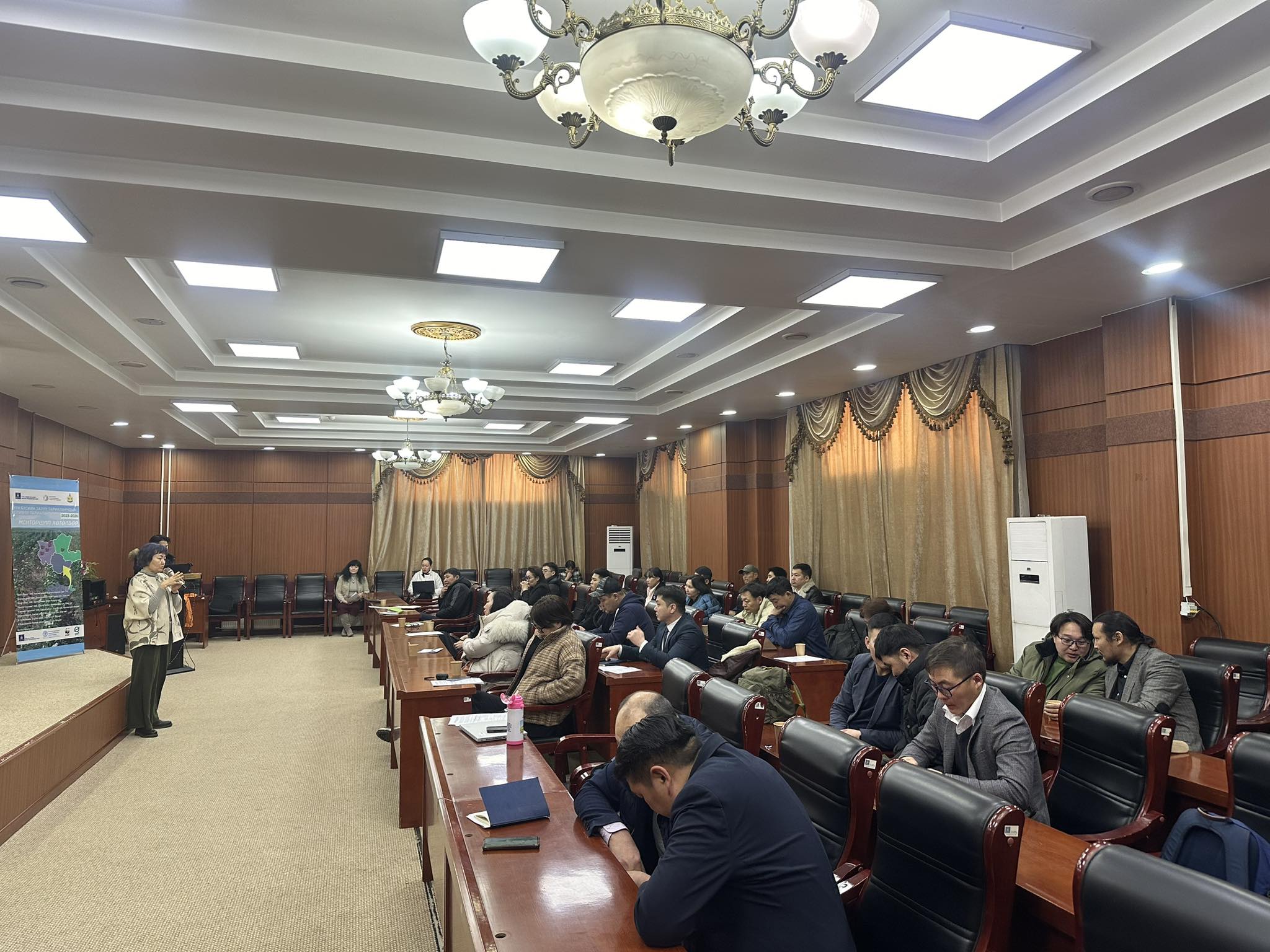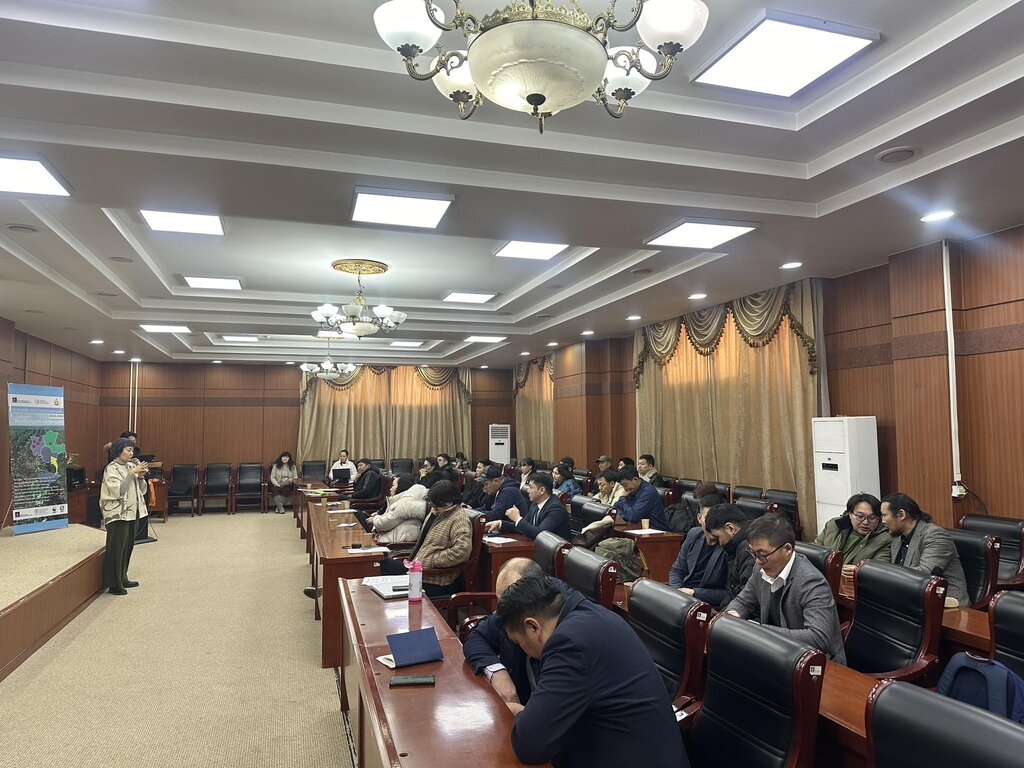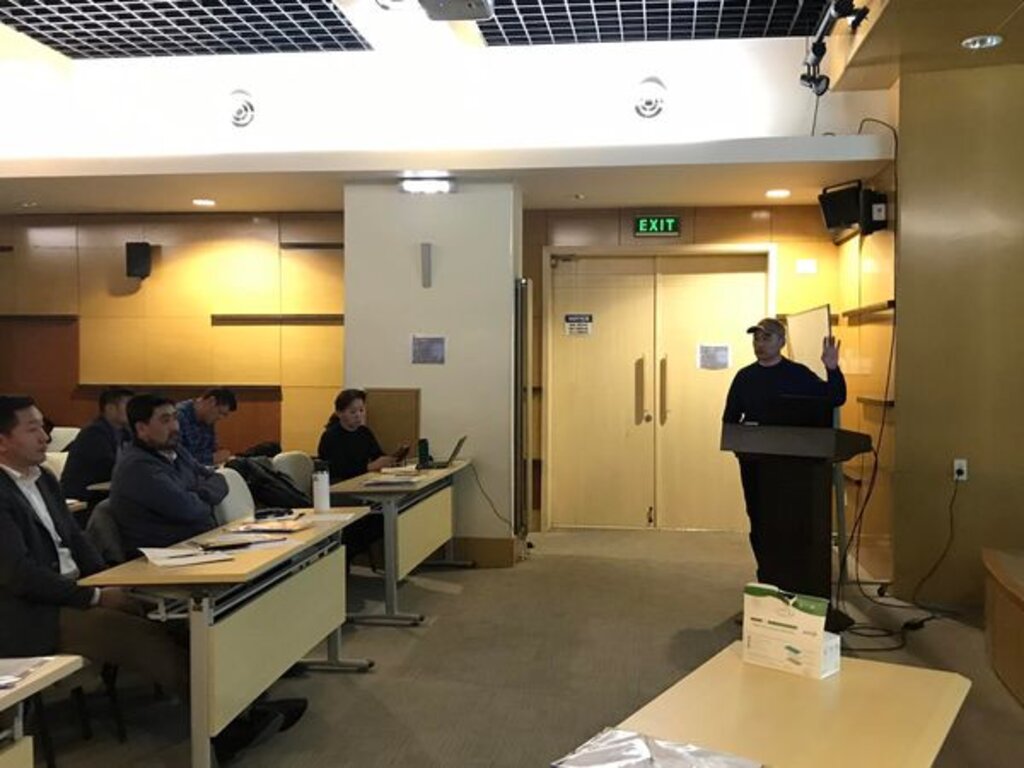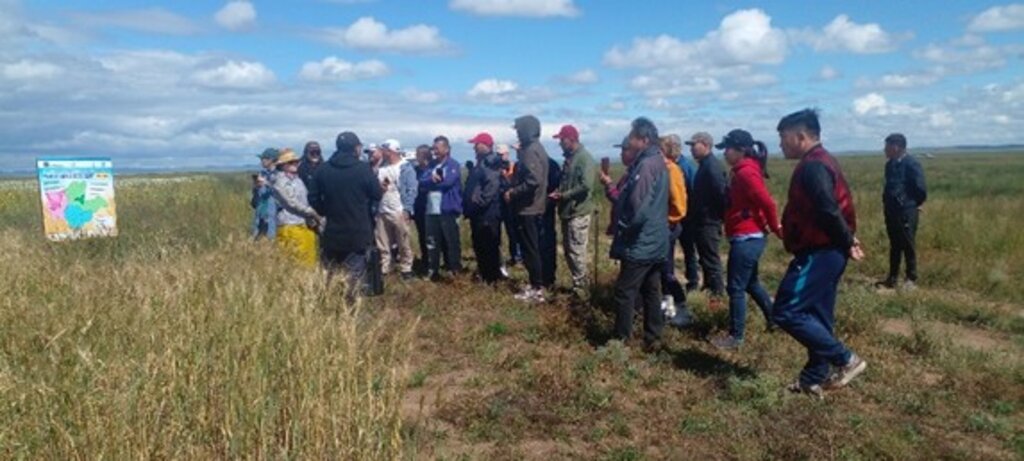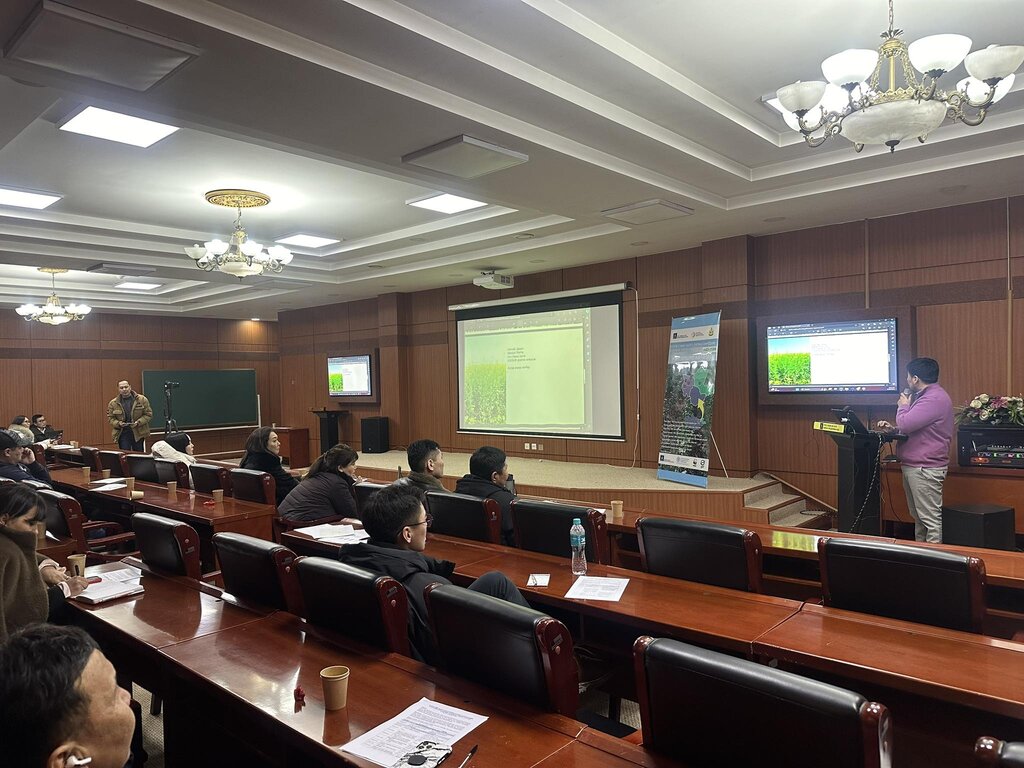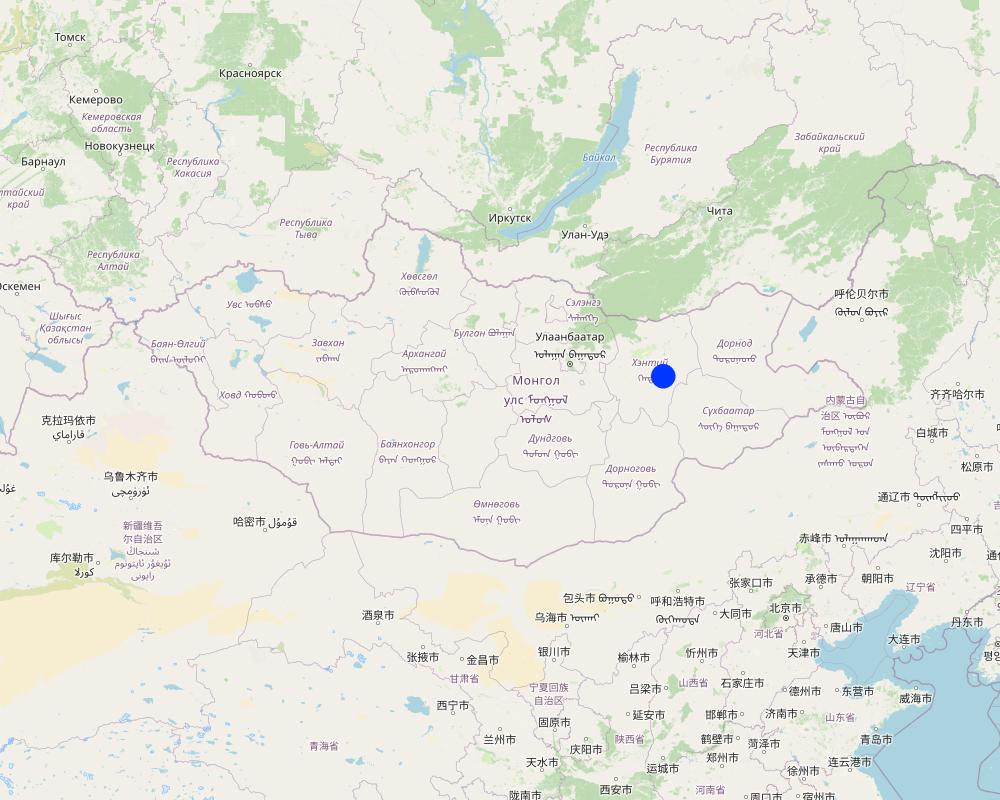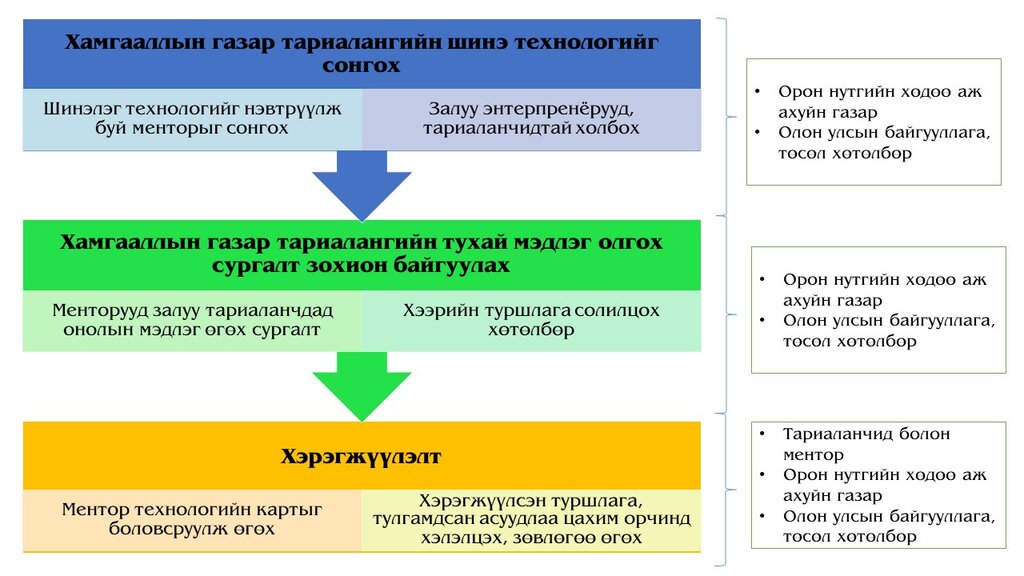Mentorship programme on conservation agriculture [Mongolia]
- Creation:
- Update:
- Compiler: Otgontsetseg Davaanyam
- Editor: Mandakh Nyamtseren
- Reviewer: Rima Mekdaschi Studer
Zaluu tarialanchiin mentor khutulbur
approaches_6995 - Mongolia
View sections
Expand all Collapse all1. General information
1.2 Contact details of resource persons and institutions involved in the assessment and documentation of the Approach
Key resource person(s)
land user:
Batdeleg Batnaran
99372580
dayanbat@gmail.com
Khentii Tarialan LLC
Kherlen soum, Khentii province
Mongolia
organizer:
organizer:
Tsend Oyungerel
80185595
oyungerel.tsend@fao.org
FAO
Mongolia
Name of project which facilitated the documentation/ evaluation of the Approach (if relevant)
Global coordination project for the SFM Dryland Sustainable Landscapes Impact Program (GEF-FAO / DSL-IP)Name of the institution(s) which facilitated the documentation/ evaluation of the Approach (if relevant)
Mongolian Academy of Sciences, Institute of Geography and Geoecology (IGG) - Mongolia1.3 Conditions regarding the use of data documented through WOCAT
When were the data compiled (in the field)?
04/10/2023
The compiler and key resource person(s) accept the conditions regarding the use of data documented through WOCAT:
Yes
1.4 Reference(s) to Questionnaire(s) on SLM Technologies
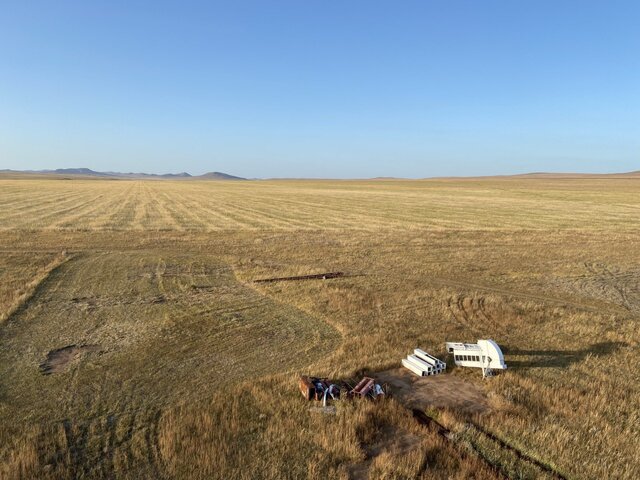
Conservation agriculture to restore abandoned cropland [Mongolia]
This technology aimed to restore abandoned cropland which was used for crop and fodder production during the 1970s-1980s. Since 2016, the farmer applied conservation agriculture and mixed cropping to reduce land degradation, revive cropping practices, increase land productivity for agriculture and enhance soil health.
- Compiler: Otgontsetseg Davaanyam
2. Description of the SLM Approach
2.1 Short description of the Approach
The Approach aims to ensure the sustainability of the agricultural sector by training and mentoring young farmers in conservation agriculture to improve soil fertility and health and maintain productivity.
2.2 Detailed description of the Approach
Detailed description of the Approach:
Within the framework of the mentorship programme, companies introducing innovative technologies in the agricultural discipline such as conservation agriculture, are selected as mentors and connected with young entrepreneurs who are new to this type of activities. Based on main principles of mentorship, the conservation agriculture training and mentorship program aims to transfer knowledge and skills gained from real-life experiences, lessons learnt, failures, and success stories from the experienced farmers to young farmers.
The mentors develop a technology card, showing main steps how to apply the technology to the young farmers. Farmers further share their experiences and knowledge gained during technology adoption through group chats and group pages on the social media, giving advice on how to fix any problems and uploading their stories on how they overcame problems in the same situation. The mentorship program involves workshops combined with in-person training to provide fundamental understanding of the SLM technology and practical field visits.
In order to empower young farmers, the Mongolian National Crop Farmers Association organized an introductory training course on mixed cropping technology and conservation agriculture (CA) in 2022. As a result of the training, young farmers who were interested in this technology became members of the mentorship program with the condition that they modify their equipment, machinery and field specifications/requirements (e.g. fencing and leaving cover on the soil surface) to adapt to CA. Total of 9 companies from nearby provinces, Dornod and Khentii, participated in the program as mentees. The mentorship program on Mixed Cropping and CA is led by Khentiin Tarialan LLC which is successfully implementing these technologies in Khentii province.
In order to sustainably maintain the mentorship program, the Mongolian National Crop Farmers Association and the project "Promoting Dryland Sustainable Landscapes and Biodiversity Conservation in the Eastern Steppe of Mongolia" implemented by FAO and WWF organize workshops for young farmers in the non-agricultural season (winter) and conduct field visits before the agricultural season (spring) every year, helping to spread good practice and knowledge.
In 2023, the mentor gave methodological advice to young farmers during a classroom lecture on how to maintain plant health, develop mixed cropping and crop rotationmaps, take soil samples with specific equipment, and how to check crop quality followed by a field visit during which participants obtained knowledge about positive impacts of mixed cropping and CA on soil restoration and financial benefits as well as at first year results, lessons learnt (success and failures) and problems encount. A total of 129 farmers from Dornod, Khentii, Sukhbaatar, Darkhan, Bulgan, Tuv and Selenge provinces participated in this training.
In addition, a closed group has been set up to share information using social networking sites, and a mentor uploads short videos on the internet to introduce the technology to people who are interested. In the future, it is planned to increase the number of mentors and topics.
Because this program is organized on a need-based and volunteer basis, parties participate with a positive attitude. Basic requirements including financial support, communication and cooperation are needed to support and sustain the implementation of the program.
2.3 Photos of the Approach
2.4 Videos of the Approach
Comments, short description:
During the field visit, the mentor introduces conservation agriculture to the participants. The video was created by a project titled "Promoting dryland sustainable landscapes and biodiversity conservation in the Eastern Steppes of Mongolia".
Location:
Kherlen soum, Khentii province
Name of videographer:
"Promoting dryland sustainable landscapes and biodiversity conservation in the Eastern Steppes of Mongolia" project
2.5 Country/ region/ locations where the Approach has been applied
Country:
Mongolia
Region/ State/ Province:
Khentii province, Kherlen soum
Further specification of location:
Takhilgat bag
Map
×2.6 Dates of initiation and termination of the Approach
Indicate year of initiation:
2022
If precise year is not known, indicate approximate date when the Approach was initiated:
less than 10 years ago (recently)
Comments:
This approach is still ongoing.
2.7 Type of Approach
- recent local initiative/ innovative
2.8 Main aims/ objectives of the Approach
The primary objective is to establish a knowledge-sharing and training network for farmers, enabling them to exchange their observations, achievements, and challenges gathered from actual experiences, and to introduce modern agricultural technologies that are resilient to climate change and have a positive impact on soil and biodiversity.
2.9 Conditions enabling or hindering implementation of the Technology/ Technologies applied under the Approach
availability/ access to financial resources and services
- hindering
Not every farmer has the opportunity to upgrade his/her machinery and take advantage of bank subsidy programs. For circulation and investment purposes banks lend to food and agricultural enterprises low loans with interest rates from about 5 to 8 per cent and 5-15 billion tugruks for 2-7 years (2023).
institutional setting
- enabling
The Ministry of Food, Agriculture and Light Industry and local administration, UNDP-FAO, General department of Land Planning, Geodesy and Mapping support the mentorship program.
collaboration/ coordination of actors
- enabling
As a result of the collaboration among the UNDP-FAO, WWF and Khentiin Tarialan LLC, other farmers can share their experiences and knowledge.
policies
- enabling
The agricultural policy at national and local level may support multi-species agriculture with high-productivity, because of their positive effects on soil protection and sustainable use. The local administrative support entities aimed to rehabilitate degraded land by renting land and providing soft loan.
land governance (decision-making, implementation and enforcement)
- enabling
It is a form of support to include it in local land management planning.
knowledge about SLM, access to technical support
- enabling
Volunteer members of the mentoring program facilitate knowledge sharing and give technical support.
markets (to purchase inputs, sell products) and prices
- hindering
Main factor affecting costs is inflation. Thus, it can have a great effect on purchasing equipment, seeds and other input. Currently, there is no demand of some of the crops on the market (e.g. flax).
workload, availability of manpower
- enabling
The implementing conservation agricultural technologies has the potential to reduce labour costs related to pest control, herbicide and fertilizer application
3. Participation and roles of stakeholders involved
3.1 Stakeholders involved in the Approach and their roles
- local land users/ local communities
Local agricultural companies and young farmers. Currently, a total of 9 agricultural companies from Dornod and Khentii provinces are participating in this program.
Exchange and enhance knowledge, connect problems and find solutions together. They are responsible for monitoring soil quality change in their field.
- SLM specialists/ agricultural advisers
Batnaran B., Mongolian, farmer. He implements mixed cropping and Conservation Agriculture in Kherlen soum, Khentii province. Currently, he is the only mentor, sharing his knowledge and training other participants. More mentors are planned to become involved.
Develop technical cards, present technological solutions, give advice and information on social networks, host Facebook group and Youtube channel.
- NGO
Mongolian National Crop Farmers Association
Organize training courses and meetings, distribute information and offer networking space for participants and farmers.
- local government
The Department of Food and Agriculture in Khentii province
Provide policy support related to land tenure and provide loan for farmers, disseminate information about mentorship program, carry out external monitoring on yield, and methodological recommendations for farmers.
- international organization
UNDP-FAO, WWF
International organizations provide financial support to organize meeting and practical training. These activities help to improve communication between farmers, broaden participant range, disseminate information on technology. Also, they provided variety of seeds that were not commonly planted in Mongolia - so that farmers can create their own seed bank.
If several stakeholders were involved, indicate lead agency:
Under the goal of revitalizing the agricultural sector of the province, the Department of Food and Agriculture in Khentii province demonstrate leadership on policy level and policy implementation.
3.2 Involvement of local land users/ local communities in the different phases of the Approach
| Involvement of local land users/ local communities | Specify who was involved and describe activities | |
|---|---|---|
| initiation/ motivation | self-mobilization | As a result of the first regional meeting, the farmers were motivated to introduce new technologies and joined the initiative to develop their farms properly under the guidance and support of the mentor. |
| planning | none | The training course and meetings are mainly organized by the Mongolian National Crop Farmers Association, International Organizations and the Department of Food and Agriculture of Khentii province. |
| implementation | self-mobilization | Farmers began the process of upgrading or adapting their machinery according to the mentor's recommendations and started to plant according to the technological card prepared by the mentor. |
| monitoring/ evaluation | passive | As the initiative is still in its beginning phase, local communities have not been directly involved in monitoring and evaluation of the Approach. But farmers implementing the conservation agricultural technology evaluate changes in soil quality and biodiversity through observation and soil sample analysis. In addition, agricultural specialists of local government evaluate the process of mentorship program based on report. |
| learn/research | interactive | Land users have gained knowledge and experience through the use of printed and electronic resources and applying in their field. |
3.3 Flow chart (if available)
Description:
Implementation phases of knowledge sharing network and mentorship program in conservation agriculture.
Author:
Otgontsetseg D.
3.4 Decision-making on the selection of SLM Technology/ Technologies
Specify who decided on the selection of the Technology/ Technologies to be implemented:
- mainly land users, supported by SLM specialists
Specify on what basis decisions were made:
- research findings
- personal experience and opinions (undocumented)
4. Technical support, capacity building, and knowledge management
4.1 Capacity building/ training
Was training provided to land users/ other stakeholders?
Yes
Specify who was trained:
- land users
Form of training:
- on-the-job
- farmer-to-farmer
- demonstration areas
- public meetings
Subjects covered:
Under the topic of conservation agriculture and its special technologies to implement, methods such as crop rotation, intercropping, mixed cropping, and leaving plant stubbles and residues in/on the soil, how they are implemented, their advantages and disadvantages were introduced.
Comments:
The training program comprises two sessions: a theoretical session in a dedicated room, during which the participants are introduced to the concept of conservation agriculture and its potential advantages and disadvantages; and a practical demonstration area, where the participants can observe the implementation of technology in action. Moreover, training participants discuss their own experiences during public meetings and mentor gives personal advice to participants when necessary.
4.2 Advisory service
Do land users have access to an advisory service?
Yes
Specify whether advisory service is provided:
- on land users' fields
- Social network
Describe/ comments:
Land users can take methodological advice from a mentor as well as specialists from local government. Within a limited group and based on social networks, there was an opportunity to receive advice on relevant issues from time to time.
4.3 Institution strengthening (organizational development)
Have institutions been established or strengthened through the Approach?
- no
4.4 Monitoring and evaluation
Is monitoring and evaluation part of the Approach?
Yes
Comments:
The farmers implementing the technology monitor changes in soil quality through observation and soil sample analysis. Soil samples collected from field are analyzed in an accepted laboratory. Local government institution does external monitoring on the Approach.
If yes, is this documentation intended to be used for monitoring and evaluation?
No
4.5 Research
Was research part of the Approach?
Yes
Specify topics:
- technology
Give further details and indicate who did the research:
To implement the technology, the farmer reviewed literature from many national and international sources. In addition, he had contact with scientists, who helped in deciding what and how to implement.
5. Financing and external material support
5.1 Annual budget for the SLM component of the Approach
Indicate the annual budget for the SLM component of the Approach in US$:
4430.00
If precise annual budget is not known, indicate range:
- 2,000-10,000
Comments (e.g. main sources of funding/ major donors):
Total annual budget of technology is approximately MNT 165.5 million or $ 48 000. This includes labor, implementation of the technology, fuel, purchase of seeds, etc. as well as organization of training courses, field visits, networking and backstopping, monitoring costs and all other expenses.
5.2 Financial/ material support provided to land users
Did land users receive financial/ material support for implementing the Technology/ Technologies?
No
5.3 Subsidies for specific inputs (including labour)
- equipment
| Specify which inputs were subsidised | To which extent | Specify subsidies |
|---|---|---|
| machinery | partly financed | None |
If labour by land users was a substantial input, was it:
- voluntary
5.4 Credit
Was credit provided under the Approach for SLM activities?
Yes
Specify conditions (interest rate, payback, etc.):
The Mongolian government has decided to provide an investment loan with purpose of supporting the food and agricultural industry in 2023. The credit grants 3-5 year loans with an interest rate of 5-6 percent to farmers in order to improve circulating capital and investment. The credit volume ranges from 5 to 15 billion MNT, depending on the bank and the size of the farm.
Specify credit providers:
The Mongolian government has signed an agreement with 10 commercial banks in Mongolia. The banks are offering soft loans with an interest rate of 5-6 percent, while the Ministry of Food and Agriculture is covering the gap between interest rates, charging 13 percent.
Specify credit receivers:
It can be an individual land user or farmer, a group such as user groups or associations and/ or a cooperative.
5.5 Other incentives or instruments
Were other incentives or instruments used to promote implementation of SLM Technologies?
Yes
If yes, specify:
Participants were eligible for subsidized loan from the Agricultural Development Fund which has ended in 2023. The Agricultural Corporation was established in 2021 by the Mongolian government. The Agricultural Corporation is a state-owned limited liability company that provides necessary products for the agricultural development of Mongolia with discounted prices and loans to farmers, allowing to repay the loans with the products produced by them. The corporation is mainly responsible for purchasing all kinds of seeds, fertilizers, plant protection substances, fuel, machinery and equipment from the domestic and international market. The farmers have the possibility to purchase equipment with discount price.
6. Impact analysis and concluding statements
6.1 Impacts of the Approach
Did the Approach empower local land users, improve stakeholder participation?
- No
- Yes, little
- Yes, moderately
- Yes, greatly
The mentorship program enabled participants to gain knowledge and experience in conservation agriculture and land restoration by organizing trainings, field visits, meetings and discussions, a fundamental basis for the successful implementation of the technology. Moreover, it supports communication and collaboration among the different stakeholders such as local administration, international organization, companies and local land users.
Did the Approach enable evidence-based decision-making?
- No
- Yes, little
- Yes, moderately
- Yes, greatly
Because first-hand experience of conservation agriculture in the field is shared through the mentorship programme, farmers make their decision to adopt conservation agriculture based on the knowledge they have gained from training, the technical and financial support they can receive.
Did the Approach help land users to implement and maintain SLM Technologies?
- No
- Yes, little
- Yes, moderately
- Yes, greatly
The mentorship program allows for the dissemination of knowledge about conservation agriculture, including both the establishment and the long-term maintenance of such practices. Furthermore, the farmers participating in the mentorship programme can seek advice through a social network and direct contact with a mentor. By sharing knowledge about conservation agriculture with other farmers, advantages, disadvantages and potential of the technology are shown, as well as the long-term efficiency and benefits for land restoration.
Did the Approach improve coordination and cost-effective implementation of SLM?
- No
- Yes, little
- Yes, moderately
- Yes, greatly
Conservation agriculture is a Арin the long term.
Did the Approach improve knowledge and capacities of land users to implement SLM?
- No
- Yes, little
- Yes, moderately
- Yes, greatly
A main goal is to improve and share knowledge about Conservation Agriculture. A mentor shares his knowledge with other land users, helping them to build and enhance their experience and knowledge.
Did the Approach improve knowledge and capacities of other stakeholders?
- No
- Yes, little
- Yes, moderately
- Yes, greatly
The meeting, organized in 2023, involved all stakeholders and presented the results of the mentorship program as well as of Conservation Agricultural and its related technologies.
Did the Approach build/ strengthen institutions, collaboration between stakeholders?
- No
- Yes, little
- Yes, moderately
- Yes, greatly
The Approach improved collaboration between stakeholders by organizing joint meetings and discussions. Generally, Mongolian National Crop Farmers Association and WWF -Mongolia jointly organize the training and meetings. Local government, farmers, international and non-governmental organizations discuss their results and problems to each other during the meeting. It allows to support further collaboration.
Did the Approach encourage young people/ the next generation of land users to engage in SLM?
- No
- Yes, little
- Yes, moderately
- Yes, greatly
The mentorship program aims to involve mainly young farmers.
Did the Approach improve the capacity of the land users to adapt to climate changes/ extremes and mitigate climate related disasters?
- No
- Yes, little
- Yes, moderately
- Yes, greatly
The Approach enhanced capacity of young farmers through training them on Conservation Agriculture, which improves resilient to climate change and disasters.
6.2 Main motivation of land users to implement SLM
- increased production
Abandoned land was put under production using CA. Hence soil fertility, moisture and health are enhanced which and crop production gradually increases.
- increased profit(ability), improved cost-benefit-ratio
The less application of pesticides and fertilizers, coupled with a reduction in the workload, leads to improve cost-benefit-ratio.
- reduced land degradation
CA promotes maintenance of a permanent soil cover, minimum soil disturbance, and diversification of plant species (FAO). Thus, it reduces land degradation by wind and water erosion.
- reduced risk of disasters
Permanent cover can help to reduce the risk of flooding or sand and dust storms.
- reduced workload
CA reduces workload because of reduced ploughing and direct seeding. Application of fertilizers and herbicides/ pesticides to control weeds, diseases and pests is at minimum.
- environmental consciousness
CA leads people to protect and restore soil and biodiversity.
- enhanced SLM knowledge and skills
CA allows people to use land efficiently over the long-term, simultaneously ensuring the maintenance of its environmental functions. These technologies are crucial for sustainable land management as they enhance soil fertility, prevent erosion, and increase water retention. Thus, land users can obtain knowledge about SLM through implementation of CA.
6.3 Sustainability of Approach activities
Can the land users sustain what has been implemented through the Approach (without external support)?
- yes
If yes, describe how:
Previously, a mentor provided advice and knowledge to other farmers through a social network and direct contact. Financial support from international organizations has enabled more farmers to participate in the mentorship program. Further, the local government can organize training, and also the mentor can personally run this program through the social network and extension center. The number of people who are interested in mentorship program is gradually increasing.
6.4 Strengths/ advantages of the Approach
| Strengths/ advantages/ opportunities in the land user’s view |
|---|
| The mentorship programme supports farmers in implementing Conservation Agriculture by training them in fundamental knowledge, particularly it involves young farmers who are the future land users. |
| Young farmers can quickly learn about Conservation Agricultural saving time and can get instructions and advice directly from a mentor with real experiences. |
| It is possible to disseminate knowledge to more people on a small budget. |
| Communication between farmers and collaboration between organizations can be improved by the Approach. During the meetings and field visits, problems and successes are discussed and experiences shared. |
| Strengths/ advantages/ opportunities in the compiler’s or other key resource person’s view |
|---|
| It is a fast way to practice young farmers in implementing conservation agriculture. |
| The social network allows participants to quickly share knowledge and experiences with each other and easily communicate with a mentor. |
| Understanding CA from people who have implemented CA. Farmers are motivated to implement conservation agriculture because of its sustainability. |
| It provides the opportunity to solve problems as a team, collecting different experiences and solutions. |
6.5 Weaknesses/ disadvantages of the Approach and ways of overcoming them
| Weaknesses/ disadvantages/ risks in the land user’s view | How can they be overcome? |
|---|---|
| In order to organize training in wide range, it needs financial support. | Financial support from other sources, including international organizations and projects. |
| Implementing CA requires farmers to adapt their equipment to the technology, which has a high initial cost. | There are soft loans from banks to support sustainable land use. The farmers can get this kind of loan. |
| Weaknesses/ disadvantages/ risks in the compiler’s or other key resource person’s view | How can they be overcome? |
|---|---|
| The training course and the field visit require a certain amount of money. Thus, the mentorship program may slow down without financial support. | It needs to get financial support or participants can give payment for the programme. |
| It requires coordination to plan trainings and field visits, and means of communication to reach farmers. | To work consistently with local government and farmers. |
| Currently, there is only one mentor training farmers. Therefore, the number of mentors with different experiences needs to be increased. | To detect new mentors with experience of conservation agriculture. |
7. References and links
7.1 Methods/ sources of information
- interviews with land users
Mentor gave general information.
- Organizers
Two informants from the international organizations supporting the mentorship programme were interviewed. They provided information about training, meeting, participants and cost.
7.3 Links to relevant information which is available online
Title/ description:
Youtube channel hosted by mentor
URL:
https://www.youtube.com/@covercropmongolia9564
Title/ description:
Facebook page sharing experiences on social network
URL:
https://www.facebook.com/profile.php?id=100063508026054
Links and modules
Expand all Collapse allLinks

Conservation agriculture to restore abandoned cropland [Mongolia]
This technology aimed to restore abandoned cropland which was used for crop and fodder production during the 1970s-1980s. Since 2016, the farmer applied conservation agriculture and mixed cropping to reduce land degradation, revive cropping practices, increase land productivity for agriculture and enhance soil health.
- Compiler: Otgontsetseg Davaanyam
Modules
No modules


